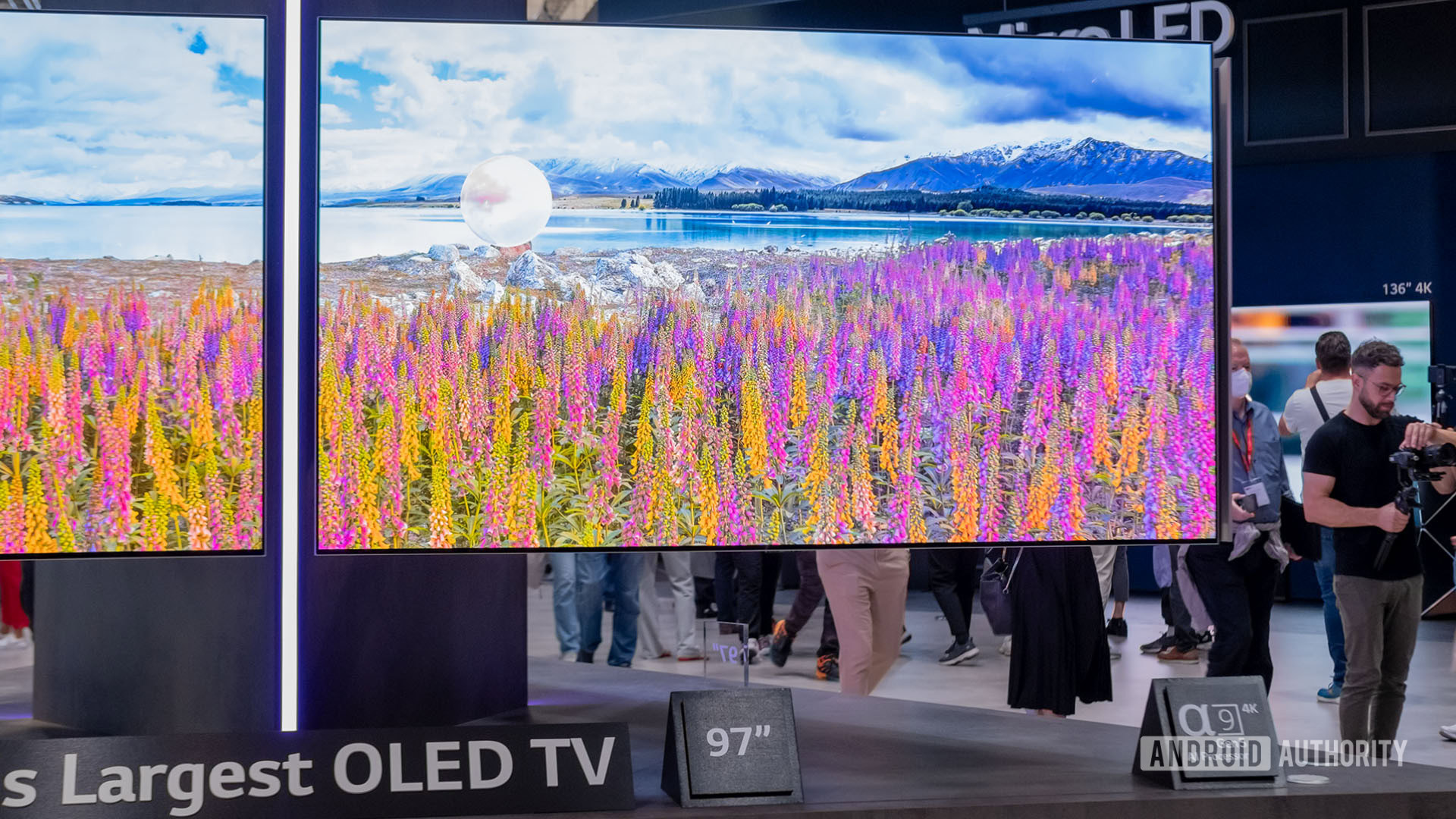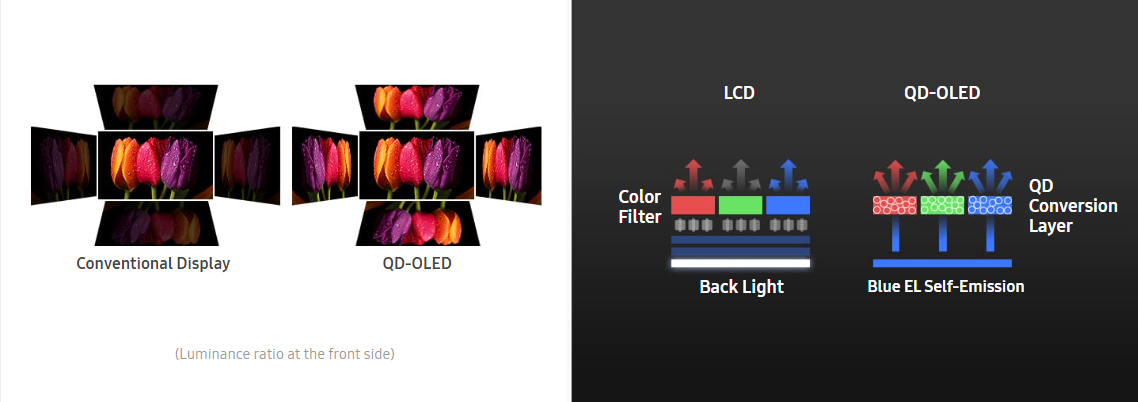QD-OLED vs. OLED: How do they compare and which one to buy?

In the world of display technologies, OLED has emerged as the clear winner because of its excellent color reproduction and contrast. From tiny smartwatches to televisions approaching 100 inches, you’ll be hard pressed to find a consumer electronics segment where the display tech hasn’t taken off. But in 2022, Samsung Display blindsided the world with its announcement of QD-OLED, a new hybrid display technology that combines quantum dots and OLED for even better picture quality.
Fast forward to today and you can now buy televisions and monitors equipped with QD-OLED technology. But you might be wondering: how does the technology work and is it any better than standard OLED?
What is QD-OLED and how does it compare vs OLED?

QD-OLED is a newer display technology than OLED that proposes to combine the vibrant colors of quantum dots with OLED’s nearly perfect black levels. To understand how these two help each other, it’s worth backing up to examine OLED and quantum dots separately.
- OLED: The O in OLED stands for organic materials, which have the property of emitting light when an electric current passes through them. These are microscopic emitters, meaning that each individual pixel on the display is its own light source. So if you need to display darker images, you can simply turn off the individual pixels to achieve true black. This is why OLED offers better contrast, black levels, and even viewing angles than traditional LCDs.
- Quantum dots: While OLED has existed for well over a decade, it wasn’t always as accessible or mass produced as it is today. So to compete in the high-end television space, manufacturers like Samsung began experimenting with adding quantum dots to LCD TVs for higher brightness and better color accuracy. You can think of quantum dots as tiny crystals that emit a range of colors when exposed to blue light. The advantages of using quantum dots in addition to standard LCD tech are that you can get a much wider range of colors, along with a bump in brightness.
Until recently, manufacturers only used quantum dots in conjunction with traditional LCDs. A blue backlight would excite the quantum dot layer to produce extremely specific shades of red and green. However, a quantum dot layer only helps in the brightness and color vibrancy departments. It does nothing for black levels or contrast, which we also need to make up a great HDR display.
And that’s how we ended up with QD-OLED, or quantum dot OLED. It’s designed to combine the excellent contrast of OLED with the vividness and brightness of quantum dot tech. How exactly does QD-OLED compare vs. regular OLED displays? Let’s break it down based on brightness, color reproduction, viewing angles, and price.
Brightness

Brightness has always stood out as OLED’s biggest weakness, especially when compared to high-end LCDs that boast powerful backlights. The organic material used in the making of OLED displays tends to degrade over time, with one factor in particular accelerating this wear: heat. Higher brightness leads to higher operating temperatures, which results in a shorter lifespan.
Manufacturers of OLED televisions have tried to overcome this limitation by mounting larger cooling apparatus over the years, but even the best models cannot compete with the mini-LED backlights of conventional LCD televisions.
QD-OLED displays can get brighter than OLED, but at what cost?
Luckily, QD-OLED overcomes this limitation somewhat because it doesn’t rely on filters to produce red, green, and blue colors. In a traditional OLED display, you’d instead have a white light that gets filtered through these color filters. Their absence in a QD-OLED display means that most of the light produced can reach your eyes.
The first QD-OLED TVs from Samsung already offered higher peak brightness than LG’s OLED displays. But only time will tell if QD-OLED offers the same kind of longevity as modern OLED panels. Moreover, the competition could motivate LG to innovate and reach higher brightness levels using conventional OLED technologies.
QD-OLED vs OLED: Color reproduction

As far as color reproduction goes, QD-OLED has the upper hand since it takes advantage of quantum dot’s ability to display vibrant shades. In terms of color gamut, the QD-OLED displays we’ve seen so far boast greater coverage of the BT2020 color space than OLED. Put simply, QD-OLED can show a greater range of colors.
Does a greater color volume matter to the average owner of a gaming monitor or TV? Not quite, as traditional OLEDs already sport wide color gamuts. However, QD-OLED definitely has the upper hand from a technical perspective. If we get content designed for the BT2020 color space in the future, QD-OLED may very well become the better pick over OLED.
Samsung Display claims QD-OLED delivers better and more accurate color saturation than OLED.
We’re not just talking about the vividness of color either. QD-OLED also has another trick up its sleeve. Unlike a traditional OLED display, it doesn’t rely on a white subpixel to boost brightness. According to Samsung Display, this difference means that colors look much more saturated and non-washed out compared to a traditional OLED display.
However, it’s worth mentioning that the white sub pixel has helped LG’s WOLED displays evade burn-in or image retention for longer. Early tests have found that QD-OLED panels experience these effects faster than OLED displays. So in the end, you may trade some longevity for the increased color volume and brightness.
Viewing angles

OLED already offers some of the best viewing angles of any display technology, but they do suffer a bit at extreme angles. If this matters to you, QD-OLED offers a solution as it loses very little luminance (brightness) as you move from side to side. Traditional OLED panels also suffer from a phenomenon known as off-axis tinting, where colors start to shift when viewed at an angle.
According to Samsung Display, QD-OLED offers better viewing angles to the tune of “34% more brightness and 50% less color shift” at a 60 degree angle. Most people don’t use a TV or monitor off-axis, so this likely won’t matter but it’s another technical advantage for QD-OLED technology.
Price

We’ve mentioned Samsung Display a few times throughout this article and that’s no coincidence. For about a decade, LG had a near-monopoly over the tech and production of larger OLED displays. Even if you bought an OLED TV from say, Sony or Vizio, the panel underneath all of the branding was likely sourced from LG.
QD-OLED represents Samsung Display’s re-entry into the OLED display space as the company seeks to fix the technology’s long standing problems of brightness, burn-in, and durability. However, it’s still cutting-edge technology so you won’t find many TVs or monitors sporting this new panel type yet. Samsung and Sony have released a handful of models, while Dell and other PC hardware manufacturers have released QD-OLED gaming monitors.
QD-OLED comes at a price premium vs OLED at the moment.
As for pricing, you’ll have to pay a premium for QD-OLED over OLED sets – you can find affordable models of the latter quite easily these days. For example, Samsung’s cheapest 55-inch QD-OLED TV retails for $1,499 on sale while you can pick up some LG OLED TVs for just over $1,100. That said, Samsung Display has managed to improve its production over time and we’ve already seen lower prices since the first-ever QD-OLED TV launched in early 2022.
The tides have shifted in the monitor space, however, and you can find 32-inch QD-OLED monitors below $1,000 now. The MSI 271QRX packs a 27-inch 1440p QD-OLED panel for $799, for example. You’ll be hard pressed to find a regular OLED monitor at similar prices as LG strugged to produce smaller panels until recently.
QD-OLED vs OLED: Which one should you get?

Based on all the technical factors we’ve analyzed so far, it’s clear that QD-OLED takes the win over OLED. While the price is higher, you do get a lot of features to compensate. But at the same time, it’s worth noting that QD-OLED lacks thorough testing, even if it’s based on two mature technologies. LG, meanwhile, has had over a decade to perfect its OLED displays in the hands of consumers.
OLED still offers a big upgrade over LCD for those that don't want the latest and greatest.
Ultimately, the choice boils down to whether you believe QD-OLED’s benefits outweigh the higher cost and slight risk of buying into a new technology. LG’s OLED still offers excellent contrast, viewing angles, and even color reproduction. If you’re upgrading from an older LCD-based TV or monitor, you will appreciate these benefits regardless of which OLED display you pick.
FAQs
Is QD-OLED better than OLED for gaming?
No, QD-OLED isn’t necessarily better than OLED for gaming if you’re looking for a competitive edge. However, QD-OLED does offer better picture quality at the expense of a higher price tag.
Does QD-OLED have less burn-in?
No, QD-OLED doesn’t have less burn-in as some tests have found quicker image retention than competing OLED displays. However, it’s still early in the technology’s life to make a definitive conclusion.
Does Samsung make QD-OLED?
Samsung Display (and not Samsung Electronics) makes QD-OLED panels for many brands, including Sony and Dell.
Does Sony use Samsung's QD-OLED tech?
Yes, some Sony TVs include Samsung Display-made QD-OLED panels. However, Sony also sells traditional WOLED TVs with panels sourced from LG.
What is WOLED?
WOLED, or White OLED, is a type of OLED display used in TVs and larger electronic devices like monitors. The W signifies the presence of a fourth white subpixel, which helps increase brightness and reduce burn-in or image retention in the long term. QD-OLED displays do not have a white sub-pixel.
from Android Authority https://ift.tt/7TFegAM


Post a Comment